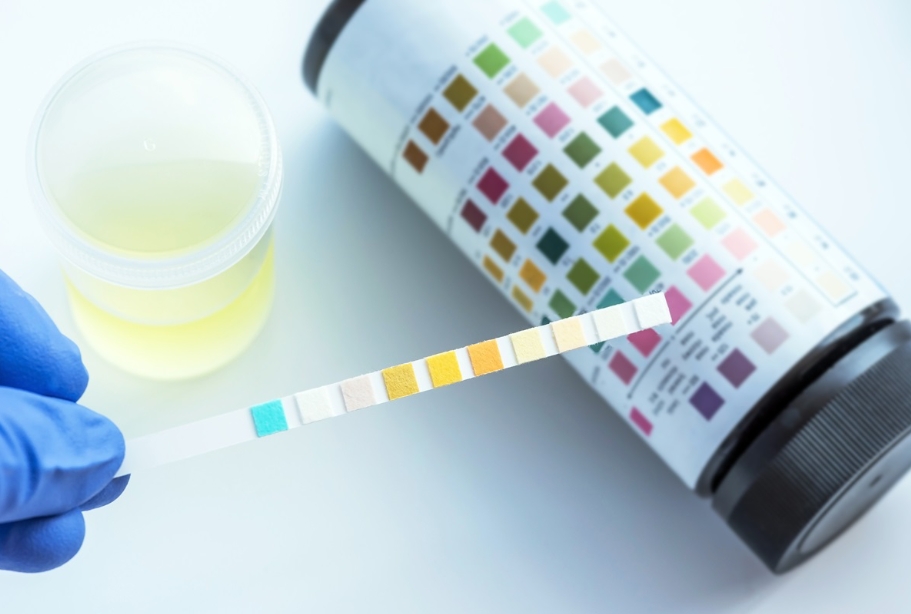A urine test (aka Urinalysis) is essential to detect urinary tract infections, diabetes, bacterial infections, kidney stones and other disorders. However, you don’t always need a trained professional to test gravity and pH in human urine. You can buy easy-to-use urine test strips online and learn how to use them to detect potential medical disorders that need treatment.
In this comprehensive guide, we shed light on how to use urine test strips to test for different parameters and read the results. Continue reading to learn more.
The Purpose of a Urinalysis
It’s part of human nature to want to keep our bodies healthy for a longer lifespan. Part of this includes maintaining a healthy lifestyle and conducting regular analyses to prevent and manage serious health issues.
Urine testing is an important analysis that can help you detect and prevent serious health issues at early stages. With quality urine test strips, you can test for a variety of health disorders, from kidney diseases to diabetes to bacterial infections.
Conducting urinalysis can be done periodically or when experiencing specific urinary symptoms. The symptoms include the following:
- Frequent urination
- Pain or burning sensation while urination
- Abdominal pains in the bladder area
- Uncontrolled urination (Being unable to stop urine from coming out)
A urine test can also be done if you suspect you are pregnant. Let’s take a look at the various urine components.
Urine Components and Their Significance
Before we dive into the various urine components, allow us to give a detailed explanation of the physical traits of urine test strips for those who are new to this. A urine test strip is a thin, narrow plastic strip with several squares of different colours attached to it. Each square represents a component of the test used to interpret the result. Below are some of the common urine components of the test.
- Glucose: This box helps indicate the blood sugar levels in your urine. Depending on your sugar concentration, the box can change to yellow, green, or brick red.
- Protein: The protein component helps detect kidney disorders or dysfunction. Usually, there is little protein in the urine. If you detect a large amount, however, it could indicate a problem with your kidney.
- Red blood cells (RBH): A higher number of RBCs in the urine can mean that you have kidney stones or other related urinary tract infections.
- Urine pH: Indicates the pH level of urine. The normal value ranges from PH 4.6 to 8.0. A higher pH may imply that you have a problem with your kidneys, which are not functioning properly to get the acids out of your bloodstream.
- Specific gravity (SG): It measures the concentration of solutes in urine. The normal range is usually between 1.005 to 1.030. A higher range can indicate that your body is dehydrated or you have extra substances like glucose.
- Ketones: It tests for diabetes, ketoacidosis, and starvation. If your urine test strip results indicate you have high levels of ketones, it’s a clear indication you have diabetes.
- Leukocytes: checks for white blood cells. It’s normal to have small amounts of blood in your urine. However, if your urine test strip results indicate higher amounts, your body may be fighting off bacterial or urinary tract infections. It can also indicate kidney inflammation.
- Nitrites: The box indicates the presence of a urinary tract infection or other types of bacteria. The bacteria in the urinary tract turns nitrates into nitrites.
- Bilirubin: If your urine test strip indicates you have bilirubin in your system, that is an early sign of a liver condition.
How Do Urine Test Strips Work
First things first, you need to get a urine sample in a clean container. If you are reusing the container, thoroughly rinse it to remove any impurities that may alter the results. At no point should you use soap to clean the container.
Once you have the sample, the test should be conducted immediately. Delays may lead to inaccurate results as the PH constantly changes with time. Having a timer can make a huge difference when testing.
Here is a step-by-step guide to using urine test strips
Before you start testing, it is essential to understand what you are testing for to use the appropriate urine test strips. The test takes around 3 minutes, while colour changes will start to appear 2 minutes later. Follow this to get accurate results.
- Once you collect your urine in a clean, dry container, swirl the urine to mix it, then immediately dip the urine test strip. Make sure you dip the right side of the strip.
- Ensure the urine in the container covers all the boxes in the test strip.
- Let the urine test strip soak for 1-2 seconds to allow saturation.
- Remove the test strip from the urine and wipe off the excess liquid.
- Set a timer of 30-60 seconds to allow the colours to change.
- Lastly, compare the colour changes with the PH colour chart (every urine test strip will have one)
How to Read Urine Test Results
If you don’t know how to read urine test strips, don’t worry; you are many on the train. Now if you have a PH colour chart with you, the process should not be complicated. This is because all you will have to do is compare the colour changes in the urine test strips with the PH colour chart. Yes, it’s that easy.
Some components, like proteins and ketones, will be reported through + signs, while others, like specific gravity or PH, will be reported as numbers. This should not stress you, as the PH chart will guide you.
Now that you know how to use urine test strips don’t wait to do a urinalysis when the symptoms appear. Do it now to prevent possible health issues, including liver dysfunction and Kidney disorder. It is also essential to understand what you are testing to get a suitable urine test strip. A pregnancy urine test strip will not give you the results of specific components like nitrites or bilirubin. Keep this in mind to save time and money.














